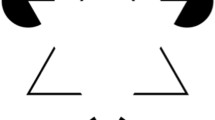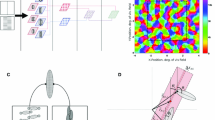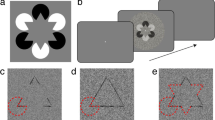Abstract
Neurophysiological, brain imaging, and perceptual studies in animals and humans suggest that illusory (occluding) contours are represented at an early level of visual cortical processing. Comparatively little is known about the mechanisms defining the depth order and the brightness illusion associated with such contours. Baumann et al. (1997) found neurons in area V2 of the alert monkey that signaled not only illusory contours but also the figure-ground direction that human observers perceive at such contours. The majority of these neurons showed this property independent stimulus contrast; a small minority preferred a certain combination of figure-ground direction and contrast polarity at these contours. In this article, we simulate the responses of these neurons by means of a grouping mechanism that uses occlusion cues (line-ends, corners) to define figure-ground direction and contrast polarity at such contours.
Similar content being viewed by others
References
Adelson EH, Bergen JR (1985) Spatio-temporal energy models for the perception of motion. J. Opt. Soc. Am. A 2:284-299.
Baumann R, van der Zwan R, Peterhans E (1997) Figure-ground segregation at contours: A neural mechanism in the visual cortex of the alert monkey. Eur. J. Neurosci. 9:1290-1303.
Bolz J, Gilbert CD, Wiesel TN (1989) Pharmacological analysis of cortical circuitry. Trends Neurosci. 12:292-296.
Coren S (1972) Subjective contours and apparent depth. Psychol. Rev. 79:359-367.
Daugman JG (1983) Six formal properties of two-dimensional anisotropic visual filters: Structural principles and frequency/orientation selectivity. IEEE Trans. Sys. Man & Cyber. 13:882-887.
Day RH, Jory MK (1980) A note on a second stage in the formation of illusory contours. Perception & Psychophys. 27:89-91.
Dobbins A, Zucker SW, Cynader MS (1987) Endstopped neurons in the visual cortex as a substrate for calculating curvature. Nature (Lond.) 329:438-441.
Dreher B (1972) Hypercomplex cells in the cat's striate cortex. Invest. Ophthalmol. 11:355-356.
Dresp B (1992) Local brightness mechanisms sketch out surfaces but do not fill them in: Psychophysical evidence in the Kanizsa Square. Perception & Psychophys. 52:562-570.
Dresp B, Bonnet C (1995) Subthreshold summation with illusory contours. Vision Res. 35:1071-1078.
Ehrenstein W (1941) Ueber Abwandlungen der L. Hermannschen Helligkeitserscheinung. Zeitschrift für Psychologie 150:83-91.
Ffytche DH, Zeki S (1996) Brain activity related to the perception of illusory contours. Neuroimage 3:104-108.
Finkel LH, Edelman GM (1989) Integration of distributed cortical systems by reentry: A computer simulation of interactive functionally segregated visual areas. J. Neurosci. 9:3188-3208.
Finkel LH, Sajda P (1992) Object discrimination based on depthfrom-occlusion. Neural Comput. 4:901-921.
Frisby JP, Clatworthy JL (1975) Illusory contours: Curious cases of simultaneous brightness contrast? Perception 4:349-357.
Fukushima K (1970) A feature extractor for curvilinear patterns: A design suggested by the mammalian visual system. Kybernetik 7:153-160.
Gerbino W, Kanizsa G (1987) Can we see constructs? In: Petry S, Meyer GE, eds. The Perception of Illusory Contours. Springer, Berlin. pp. 246-252.
Gerrits HJM, Vendrik AJH (1970) Simultaneous contrast filling-in process and information processing in man's visual system. Exp. Brain Res. 11:411-430.
Gilbert CD (1977) Laminar differences in receptive field properties of cells in cat primary visual cortex. J. Physiol. 268:391-421.
Gove A, Grossberg S, Mingolla E (1995) Brightness perception, illusory contours, and corticogeniculate feedback. Visual Neurosci. 12:1027-1052.
Grinvald A, Lieke E, Frostig RD, Gilbert CD, Wiesel TN (1986) Functional architecture of cortex revealed by optical imaging of intrinsic signals. Nature 324:361-364.
Grosof DH, Shapley RM, Hawken MJ (1993) Macaque V1 neurons can signal "illusory" contours. Nature 365:550-552.
Grossberg S (1987a) Cortical dynamics of three-dimensional form, color, and brightness perception: I. Monocular theory. Perception & Psychophys. 41:87-116.
Grossberg S (1987b) Cortical dynamics of three-dimensional form, color, and brightness perception: II. Binocular theory. Perception & Psychophys. 41:117-158.
Grossberg S (1997) Cortical dynamics of three-dimensional figure-ground perception of two-dimensional pictures. Psychol. Rev. 3:618-658.
Grossberg S, Mingolla, E (1985) Neural dynamics of perceptual grouping: Textures, boundaries, and emergent segmentations. Perception & Psychophys. 38:141-171.
Hawken MJ, Parker AJ (1987) Spatial properties of neurons in the monkey striate cortex. Proc. R. Soc. Lond B 231:251-288.
Heider B, Meskenaite, V, Peterhans E (2000) Anatomy and physiology of a neural mechanism defining depth order and contrast polarity at illusory contours. Eur. J. Neurosci. 12:4117-4130.
Heitger F, Peterhans E (1996) A neuronal model detecting figure-ground direction and contrast polarity at illusory contours. Perception 25:28-29.
Heitger F, Rosenthaler L, von der Heydt R, Peterhans E, Kübler O (1992) Simulation of neural contour mechanisms: From simple to end-stopped cells. Vision Res. 32:963-981.
Heitger F, von der Heydt R, Peterhans E, Rosenthaler L, Kübler O (1998) Simulation of neural contour mechanisms: Representing anomalous contours. Image & Vision Computing 16:407-421.
Hirsch J, De La Paz RL, Relkin NR, Victor J, Kim K, Li T, Borden P, Rubin N, Shapley R (1995) Illusory contours activate specific regions in human visual cortex: Evidence from functional magnetic resonance imaging. Proc. Nat. Acad. Sci. USA 92:6469-6473.
Hubel DH (1988) Eye, Brain, and Vision. Scientific American Library, New York.
Hubel DH, Wiesel TN (1962) Receptive fields binocular interaction and functional architecture in the cat's visual cortex. J. Physiol. (Lond.) 160:106-154.
Hubel DH, Wiesel TN (1965) Receptive fields, and functional architecture in two nonstriate visual areas (18 and 19) of the cat. J. Neurophysiol. 28:229-289.
Hubel DH, Wiesel TN (1968) Receptive fields and functional architecture of monkey striate cortex. J. Physiol. (Lond.) 195:215-243.
Kanizsa G (1979) Organization in Vision: Essays on Gestalt Perception. Praeger, New York.
Kato H, Bishop PO, Orban GA (1978) Hypercomplex and simple/ complex cell classifications in cat striate cortex. J. Neurophysiol. 41:1071-1095.
Kennedy JM (1979) Subjective contours, contrast, and assimilation. In: Nodine CF, Fisher DF, eds. Perception and Pictorial Representation. Praeger, New York, pp. 167-195.
Koenderink JJ, van Doorn AJ (1987) Representation of local geometry in the visual system. Biol. Cybern. 55:367-376.
Kulikowski JJ, Marčelja S, Bishop PO (1982) Theory of spatial position and spatial frequency relations in the receptive fields of simple cells in the visual cortex. Biol. Cybern. 43:187-198.
Larsson J, Amunts K, Gulyás B, Malikovic A, Zilles K, Roland, PE (1999) Neuronal correlates of real and illusory contour perception: Functional anatomy with PET. Eur. J. Neurosci. 11:4024-4036.
Lesher GW (1995) Illusory contours: Toward a neurally based perceptual theory. Psychonomic Bull. Rev. 2:279-321.
Leventhal AG, Zhou Y (1994) Cat visual cortical cells are sensitive to the orientation and direction of "illusory" contours. Soc. Neurosci. Abstr. 20:1053.
Lourens T (1998) A biologically plausible model for corner-based object recognition from color images. Ph.D. thesis, University of Groningen, The Netherlands.
Maske R, Yamane S, Bishop PO (1986) End-stopped cells and binocular depth discrimination in the striate cortex of cats. Proc. R. Soc. Lond. B 229:257-276.
Mendola JD, Dale AM, Fischl B, Liu AK, Tootell RBH (1999) The representation of illusory and real contours in human cortical visual areas revealed by functional magnetic resonance imaging. J. Neurosci. 19:8560-8572.
Morrone MC, Burr DC (1988) Feature detection in human vision: A phase-dependent energy model. Proc. R. Soc. Lond. B 235:221-245.
Nakayama K, Shimojo S (1990) Da Vinci stereopsis: Depth and subjective occluding contours from unpaired image points. Vision Res. 30:1811-1825.
Nakayama K Shimojo S, Silverman GH (1989) Stereoscopic depth: Its relation to image segmentation, grouping, and the recognition of occluded objects. Perception 18:55-68.
Neumann H, Pessoa L, Mingolla, E (1998) A neural architecture of brightness perception: Non-linear contrast detection and geometry-driven diffusion. Image & Vision Computing 16:423-446.
Orban GA, Kato H, Bishop PO (1979) Dimensions and properties of end-zone inhibitory areas in the receptive fields of hypercomplex cells in cat striate cortex. J. Neurophysiol. 42:833-849.
Paradiso MA, Nakayama K (1991) Brightness perception and filling-in. Vision Res. 31:1221-1236.
Peterhans E (1997) Functional organization of area V2 in the awake monkey. In: Rockland KS, Kaas JH, Peters A, eds. Cerebral Cortex (V12). Plenum Press, New York. pp. 335-357.
Peterhans E, von der Heydt R (1989) Mechanisms of contour perception in monkey visual cortex. II. Contours bridging gaps. J. Neurosci. 9:1749-1763.
Peterhans E, von der Heydt R (1991) Elements of form perception in monkey prestriate cortex. In: Gorea A, Frégnac Y, Kapoulis Z, Findlay J, eds. Representations of Vision: Trends and Tacit Assumptions. Cambridge University Press, Cambridge. pp. 111-124.
Peterhans E, von der Heydt R, Baumgartner G (1986) Neuronal responses to illusory contour stimuli reveal stages of visual cortical processing. In: Pettigrew JD, Sanderson KJ, Levick WR, eds. Visual Neuroscience. Cambridge University Press, Cambridge. pp. 343-351.
Petry S, Meyer GE (1987) The Perception of Illusory Contours. Springer, Berlin.
Prazdny K (1983) Illusory contours are not caused by simultaneous brightness contrast. Perception & Psychophysics 34:403-404.
Ramachandran VS, Anstis S (1986) Figure-ground segregation modulates apparent motion. Vision Res. 26:1969-1975.
Redies C, Crook JM, Creutzfeldt OD (1986) Neuronal responses to borders with and without luminance gradients in cat visual cortex and dorsal lateral geniculate nucleus. Exp. Brain Res. 61:469-481.
Rose D (1977) Responses of single units in cat visual cortex to moving bars of light as a function of bar length. J. Physiol. 271:1-23.
Schiller PH, Finlay BL, Volman SF (1976) Quantitative studies of single-cell properties in monkey striate cortex. I. Spatiotemporal organization of receptive fields. J. Neurophysiol. 39:1288-1319.
Sheth BR, Sharma J, Rao SC, Sur M (1996) Orientation maps of subjective contours in visual cortex. Science 274:2110-2115.
Skottun BC (1998) A model for end-stopping in the visual cortex. Vision Res. 38:2023-2035.
Spillmann L, Dresp B (1995) Phenomena of illusory form: Can we bridge the gap between levels of explanation? Perception 24:1333-1364.
van der Zwan R, Baumann R, Peterhans E (1995) End-stopped cells in the visual cortex of the alert monkey. Perception 24:43.
Versavel M, Orban GA, Lagae L (1990) Responses of visual cortical neurons to curved stimuli and chevrons. Vision Res. 30:235-248.
von der Heydt R, Peterhans E (1989) Mechanisms of contour perception in monkey visual cortex. I. Lines of pattern discontinuity. J. Neurosci. 9:1731-1748.
von der Heydt R, Peterhans E, Baumgartner G (1984) Illusory contours and cortical neuron responses. Science 224:1260-1262.
Walker GA, Ohzawa, I, Freeman RD (2000) Suppression outside the classical cortical receptive field. Vis. Neurosci. 17:369-379.
Ware C (1981) Subjective contours independent of subjective brightness. Perception & Psychophys. 29:500-504.
Westheimer G, Li W (1996) Classifying illusory contours by means of orientation discrimination. J. Neurophysiol. 75:523-528.
Zetzsche C, Barth E (1990) Fundamental limits of linear filters in the visual processing of two-dimensional signals. Vision Res. 30:1111-1117.
Zhou H, Friedman HS, von der Heydt R (2000) Coding of border ownership in monkey visual cortex. J. Neurosci. 20:6594-6611.
Author information
Authors and Affiliations
Rights and permissions
About this article
Cite this article
Peterhans, E., Heitger, F. Simulation of Neuronal Responses Defining Depth Order and Contrast Polarity at Illusory Contours in Monkey Area V2. J Comput Neurosci 10, 195–211 (2001). https://doi.org/10.1023/A:1011273115282
Issue Date:
DOI: https://doi.org/10.1023/A:1011273115282




